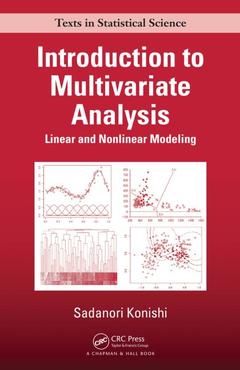Introduction to Multivariate Analysis Linear and Nonlinear Modeling Chapman & Hall/CRC Texts in Statistical Science Series

Select the Optimal Model for Interpreting Multivariate Data
Introduction to Multivariate Analysis: Linear and Nonlinear Modeling shows how multivariate analysis is widely used for extracting useful information and patterns from multivariate data and for understanding the structure of random phenomena. Along with the basic concepts of various procedures in traditional multivariate analysis, the book covers nonlinear techniques for clarifying phenomena behind observed multivariate data. It primarily focuses on regression modeling, classification and discrimination, dimension reduction, and clustering.
The text thoroughly explains the concepts and derivations of the AIC, BIC, and related criteria and includes a wide range of practical examples of model selection and evaluation criteria. To estimate and evaluate models with a large number of predictor variables, the author presents regularization methods, including the L1 norm regularization that gives simultaneous model estimation and variable selection.
For advanced undergraduate and graduate students in statistical science, this text provides a systematic description of both traditional and newer techniques in multivariate analysis and machine learning. It also introduces linear and nonlinear statistical modeling for researchers and practitioners in industrial and systems engineering, information science, life science, and other areas.
Introduction. Linear Regression Models. Nonlinear Regression Models. Logistic Regression Models. Model Evaluation and Selection. Discriminant Analysis. Bayesian Classification. Support Vector Machines. Principal Component Analysis. Clustering. Appendices. Bibliography. Index.
Date de parution : 07-2014
15.2x22.9 cm
Date de parution : 06-2020
15.6x23.4 cm
Thèmes d’Introduction to Multivariate Analysis :
Mots-clés :
Nonlinear Discriminant Function; Basis Function Matrix; Extracting Patterns From Multivariate Data; Calcium Oxalate Crystals; Understanding The Structure Of Random Phenomena; Gaussian Basis Functions; L1 Norm Regularization; Weight Vector; Models For Interpreting Multivariate Data; Log Likelihood Function; Nonlinear Techniques For Multivariate Data; Discriminant Function; Nonlinear Logistic Regression Model; Optimum Separating Hyperplane; Sample Variance Covariance Matrix; Separating Hyperplane; Class Indicator Variable; Sample Variance Covariance Matrices; Nonlinear Regression Model; Intercluster Distance; Posterior Probabilities; Natural Cubic Spline; Regression Model; Data Set; Linearly Separable; Kernel PCA; Linearly Nonseparable; Stimulus Levels; Non-linear Principal Component Analysis; Fusion Level



